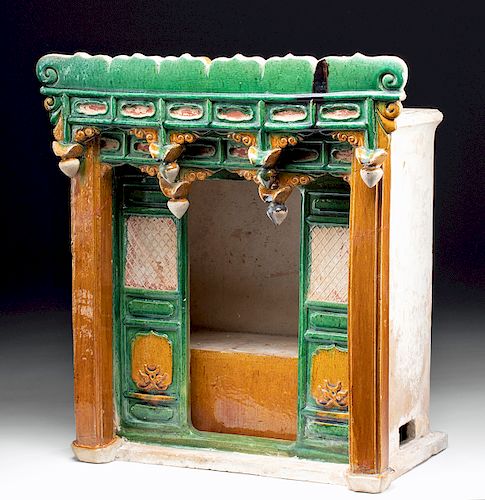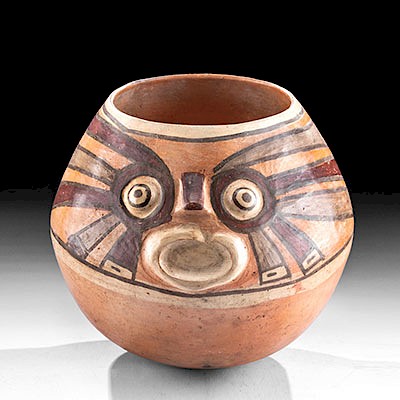Chinese Ming Ceramic Wedding Bed Tile w/ Sancai Glaze
Lot 78
About Seller
Artemis Fine Arts
686 S Taylor Ave, Ste 106
Louisville, CO 80027
United States
Selling antiquities, ancient and ethnographic art online since 1993, Artemis Gallery specializes in Classical Antiquities (Egyptian, Greek, Roman, Near Eastern), Asian, Pre-Columbian, African / Tribal / Oceanographic art. Our extensive inventory includes pottery, stone, metal, wood, glass and textil...Read more
Categories
Estimate:
$3,000 - $6,000
Absentee vs Live bid
Two ways to bid:
- Leave a max absentee bid and the platform will bid on your behalf up to your maximum bid during the live auction.
- Bid live during the auction and your bids will be submitted real-time to the auctioneer.
Bid Increments
| Price | Bid Increment |
|---|---|
| $0 | $25 |
| $300 | $50 |
| $1,000 | $100 |
| $2,000 | $250 |
| $5,000 | $500 |
| $10,000 | $1,000 |
| $20,000 | $2,500 |
| $50,000 | $5,000 |
| $100,000 | $10,000 |
| $200,000 | $20,000 |
About Auction
By Artemis Fine Arts
Dec 5, 2019
Set Reminder
2019-12-05 10:00:00
2019-12-05 10:00:00
America/New_York
Bidsquare
Bidsquare : Ancient / Ethnographic - Holiday Edition
https://www.bidsquare.com/auctions/artemis-gallery/ancient-ethnographic---holiday-edition-4710
What to give this holiday season? Ancient & Ethnographic Art of course! Our special Holiday auction features hundreds of unique finds from all over the world. Artemis Fine Arts info@artemisgallery.com
What to give this holiday season? Ancient & Ethnographic Art of course! Our special Holiday auction features hundreds of unique finds from all over the world. Artemis Fine Arts info@artemisgallery.com
- Lot Description
East Asia, China, Ming Dynasty, ca. 1368 to 1644. A fine and quite large earthenware wedding bed roof tile presenting an elegant form with an elaborate entablature, columns to either side, and an interior space featuring a stage-like platform with decorative screens before it. The sumptuous bed is skillfully made via slab construction with molded decorative elements and glazed in Sancai colors. The word Sancai means 'three colors', and is achieved by using different oxides mixed with varnishes heated at a low-temperature. With iron the artist could obtain the yellow; copper gives the green or sometimes the dark brown color; and in some cases, cobalt was used to create blue. This pursuit of various colors dates back to the Han period, when artists tried to imitate bronze objects. Size: 9.75" L x 17.875" W x 19.25" H (24.8 cm x 45.4 cm x 48.9 cm)
This decorative tile would have been placed where the roof lines met. As a wedding bed it was intended to represent the tranquil union of a happy marriage. The striking colors of the sancai glaze enabled it to be seen from a distance, while the artist's attention to detail made close viewing just as rewarding. The small rectangular openings on the sides of the tile indicate were created to insert the wooden roof beams.
Provenance: ex-Chow Su San Antiques Co. LTD, Hong Kong, China, acquired in 1989
All items legal to buy/sell under U.S. Statute covering cultural patrimony Code 2600, CHAPTER 14, and are guaranteed to be as described or your money back.
A Certificate of Authenticity will accompany all winning bids.
We ship worldwide and handle all shipping in-house for your convenience.
#150509A few repairs to slabs but these are only visible on the unfinished back/side ends. Minor nicks to peripheries of high-pointed elements.Condition
- Shipping Info
-
All shipping is handled in-house for your convenience. Your invoice from Artemis Gallery will include shipping calculation instructions. If in doubt, please inquire BEFORE bidding for estimated shipping costs for individual items.
-
- Buyer's Premium



 EUR
EUR CAD
CAD AUD
AUD GBP
GBP MXN
MXN HKD
HKD CNY
CNY MYR
MYR SEK
SEK SGD
SGD CHF
CHF THB
THB














